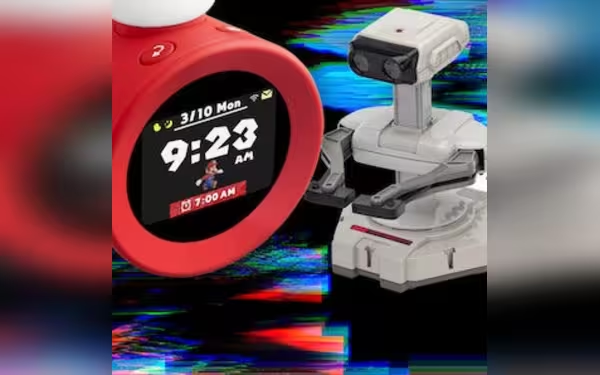Saturday, November 16, 2024 08:52 PM
Nintendo's Alarmo: A Quirky Addition to Its Eccentric Hardware Lineup
- Nintendo launches the quirky 'Alarmo' alarm clock.
- Reflecting on Nintendo's history of unusual hardware.
- From 'Virtual Boy' to 'Wii Balance Board,' innovation continues.
 Image Credits: ign_pk
Image Credits: ign_pkNintendo unveils 'Alarmo,' an alarm clock featuring sounds from popular games, adding to its legacy of quirky hardware.
Nintendo has long been known for its innovative and sometimes eccentric approach to gaming hardware. The company has a rich history of creating unique devices that often defy conventional expectations. Recently, Nintendo unveiled its latest quirky product, the "Nintendo Sound Clock: Alarmo," priced at $100. This alarm clock is designed to wake users with sounds and songs from popular games like "Breath of the Wild," "Super Mario Odyssey," "Splatoon 3," "Ring Fit Adventure," and "Pikmin 4." While it may not be the groundbreaking hardware fans have been eagerly anticipating, it certainly adds to Nintendo's reputation as the "crazy toymaker" of the video game industry.
The introduction of Alarmo has prompted a reflection on some of the other unusual devices Nintendo has released over the years. Notably, the "Virtual Boy," launched in 1995, stands out as one of the biggest flops in Nintendo's history. With its red and black display, it was notorious for causing headaches and sold fewer than one million units. Despite its failure, some fans still remember the "Virtual Boy Wario Land" game fondly, and there are hopes that Nintendo might one day offer a virtual console library for it on the Nintendo Switch Online.
Another interesting piece of hardware from Nintendo's past is the "Robotic Operating Buddy," or R.O.B., which was released for the NES in 1985. This device was intended to be a second player in games, but it only worked with two titles, "Gyromite" and "Stack-Up." Unfortunately, R.O.B. was difficult to set up and operated so slowly that it was likened to "watching grass grow." Despite its shortcomings, R.O.B. remains a beloved character in the "Smash Bros." series.
In the realm of portable technology, Nintendo attempted to create a camera accessory for the Game Boy called the "Game Boy Camera." This device allowed users to take low-resolution photos and print them using the "Game Boy Printer." Although it was a niche product, it showcased Nintendo's willingness to experiment with new ideas.
Another notable accessory was the "Circle Pad Pro" for the original 3DS, which added a second circle pad and extra shoulder buttons to the handheld console. While it was a bulky solution for games requiring twin-stick controls, it was quickly overshadowed by the release of the New 3DS, which included a built-in second analog stick.
One of the most bizarre collaborations was with Kellogg’s to create the "Delicious amiibo," which was part of a cereal box that functioned as an amiibo in compatible Nintendo games. This unique product combined breakfast with gaming in a way that had never been seen before.
During the GameCube era, Nintendo bundled a microphone with games like "Mario Party 6" and "Mario Party 7" to enable voice-controlled mini-games. Although the microphone's responsiveness was sometimes lacking, it added a fun twist to the gaming experience.
Nintendo has also made a significant impact in the fitness gaming sector, with products like the "Wii Balance Board" and the "Ring Con" from "Ring Fit Adventure." These devices have been integral to the success of their respective games, encouraging players to stay active while having fun.
Nintendo's history of unconventional hardware reflects its commitment to creativity and innovation in the gaming industry. While not every product has been a success, each attempt has contributed to the company's unique identity. As fans eagerly await future announcements, it is clear that Nintendo will continue to surprise and delight with its imaginative approach to gaming hardware.













